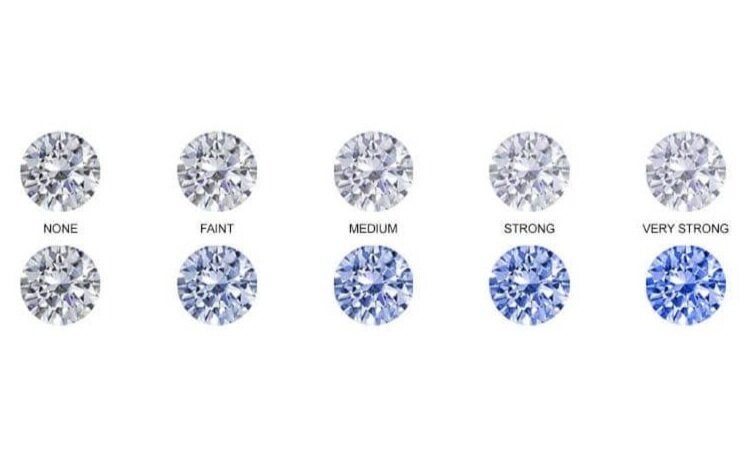All About Fluorescence
Hello, my friends! Welcome back to the Requiem Report Blog. Now that you’ve learned a bit about the Four C’s of diamonds, it’s time to dive in to some other important diamond characteristics (if you haven’t read the Four C’s post yet, check it out here) . This post is going to teach you all about something called Fluorescence - you’ll learn what is is, how to spot it, and whether or not you should avoid it. Let’s get started!
So the first and most obvious question… What is Fluorescence? Well, it is a naturally occurring gas that is present in about 30% of diamonds that can sometimes cause visible defects. The dictionary definition of fluorescence as a general term is, “the visible radiation emitted by certain substances as a result of incident radiation of a shorter wavelength such as X-rays or ultraviolet light”, and this is exactly what diamond fluorescence refers to. Fluorescent diamonds will actually emit a visible light when exposed UV rays, and that light is almost always a blue color.
So- how do we know if a diamond has fluorescence? We simply place the diamond under direct ultraviolet light and record how it behaves. If you’re out in the sun, or if you go bowling and find yourself under a black light and your ring is glowing blue- that is fluorescence!
The photo on the left shows a fluorescent diamond in natural sunlight, while the photo on the right shows a fluorescent diamond under Ultraviolet light.
So like I said, fluorescence occurs in nearly one third of natural diamonds, but not all fluorescent diamonds are created equal! Like all diamond characteristics, fluorescence is judged on an increasing scale. When a diamond is tested for fluorescence, it will receive one of the following descriptions: “None”, “Faint”, “Medium”, “Strong”, or “Very Strong”. These descriptions refer to the intensity of the blue color that the diamond emits when it is exposed to UV light.
Diamond Fluorescence Scale - Natural Light (top) vs UV Light (bottom)
So… is fluorescence good or bad? This is a tricky question to answer, because it can be both! Let’s start with “faint” fluorescence.
If a diamond is given a “faint” fluorescence description, the visible effect on the diamond is almost always negligible. A trained expert under a proper light source would be able to spot it, but otherwise, it probably wouldn’t affect the diamonds appearance to the naked eye. So I wouldn’t worry too much about a “faint” fluorescent diamond! But as I said, fluorescence is an increasing scale… and the diamonds that are described as having “strong” or “very strong” fluorescence are the ones you want to look out for! Let me explain why.
When a diamond emits a “strong” or “very strong” blue light under UV rays, that diamond will usually have a hazy quality to it. Even in natural light, diamonds with heavy fluorescence will look somewhat milky and can have visible blue undertones. This haziness can become more or less visible under different lighting circumstances, but the milky effect will almost always be present in highly fluorescent diamonds. Take a look at the example below!
The diamond on the right is an example of the “milky” quality that can be caused by strong or very strong fluorescence- compared to the diamond on the left that has zero fluorescence.
Because of this hazy/oily quality that can be present in strongly fluorescent diamonds, I typically steer clear of them. But (of course) there is a caveat! There is one scenario where fluorescence might do a little good… and that is if you have a low color diamond. If a diamond has a lower color grading, the blue undertones caused by fluorescence can actually make it appear a bit whiter. The blue somehow counteracts the yellow/brown hues in the diamond and makes it seem brighter! Cool, right?
The other effect of fluorescence that can be a good thing is… price! Yes, diamonds with fluorescence typically sell about 10-15% lower than comparable diamonds without fluorescence. This discount is mainly due to the paragraph above… Because fluorescence can make a diamond appear whiter, fluorescent diamonds trade at a lower price to account for any grading errors that may have taken place. Fluorescence will not affect the durability or longevity of a diamond by any means; so, if a little blue doesn’t bother you, get yourself a good deal!
Whether fluorescence is ‘good’ or ‘bad’ can vary on a case by case basis; but ultimately, you should pick the diamond that speaks to you the most! I hope you enjoyed learning about this interesting diamond characteristic… check out other #RequiemReport blog posts and videos to expand your diamond knowledge even more!




